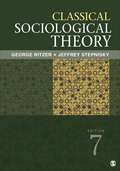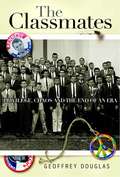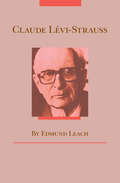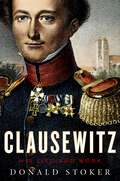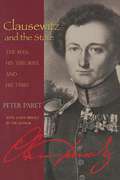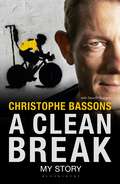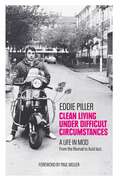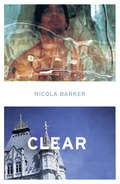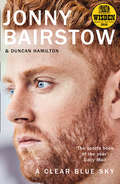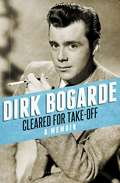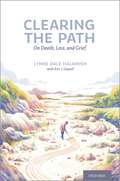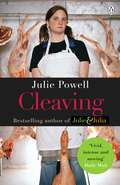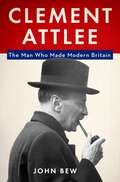- Table View
- List View
Classical Sociological Theory (Seventh Edition) (PDF)
by George Ritzer Jeffrey StepniskyClassical Sociological Theory, Seventh Edition provides a comprehensive overview of the major theorists and schools of sociological thought from the Enlightenment roots of theory through the early 20th Century. The integration of key theories with biographical sketches of theorists and the requisite historical and intellectual context helps students to better understand the original works of classical authors as well as to compare and contrast classical theories.
The Classmates: Privilege, Chaos, and the End of an Era
by Geoffrey DouglasFifty years ago, in the fall of 1957, two thirteen-year-old boys were enrolled at an elite, boys-only New England boarding school. One of them, descended from wealth and eminence, would go on to Yale, then to a career as a navy officer and Vietnam war hero, and finally to the U.S. Senate, from where he would fall just short of the White House. The other was a scholarship student, a misfit giant of a boy from a Pennsylvania farm town who would suffer shameful debasements at the hands of his classmates, then go on to a solitary and largely anonymous life as a salesman of encyclopedias and trailer parts--before dying, alone, twelve months after his classmate's narrow loss on Election Day 2004. It is around these two figures, John Kerry and a boy known here only as Arthur, the bookends of a class of one hundred boys, that Geoffrey Douglas--himself a member of that boarding-school class--builds this remarkable memoir. His portrait of their lives and the lives of five others in that class--two more Vietnam veterans with vastly divergent stories, a federal judge, a gay New York artist who struggled for years to find his place in the world, and Douglas himself--offers a memorable look back to a generation caught between the expectations of their fathers and the sometimes terrifying pulls of a society driven by war, defiance, and self-doubt. The class of 1962 was not so different from any other, with its share of swaggerers and shining stars, outcasts and scholarship students. Its distinction was in its timing: at the precise threshold of the cultural and political upheavals of the late 1960s. The world these boys had been trained to enter and to lead, a world very similar to their fathers', would be exploded and recast almost at the moment of their entrance--forcing choices whose consequences were sometimes lifelong. Douglas's chronicle of those times and choices is both a capsule history of an era and a literary tour de force.
Claude Levi-Strauss
by Edmund LeachIn this lucide guide to the often abstruse works of Claude Lévi-Strauss, Edmund Leach synthesizes the thought of one of the twentieth century's greatest anthropologists and provides a thoughtful introduction to the theory and practice of structuralism. Leach organizes his work not by chronology but by theme, exploring three important topics in Lévi-Strauss's work: human beings and their symbols, the structure of myth, and kinship theory. Written concisely and with great care and penetration, this brief book is both a fine introduction for the uninitiated reader of Lévi-Strauss and a critical analysis that will prove valuable to those more familiar with the anthropologist's work.
Claude Monet (Great Artists)
by Ann SumnerClaude Monet's tranquil water-lily paintings and rural landscape scenes are among some of the most treasured artworks of the 19th and 20th centuries. Hailed as the 'Prince of Impressionism' for his pioneering role in the French artistic movement, Monet is widely recognised for his free brushstroke and experimentation with colour and natural light. In this beautifully illustrated book, Ann Sumner explores the life of this prodigious painter and the subjects that obsessed him: the cliffs of the Normandy coastline, the palazzos of Venice, the railway stations of Paris, the great edifice of Rouen Cathedral, and his beloved garden at Giverny. Showcasing a selection of his best-loved and lesser-known paintings alongside fascinating biographic detail, this guide serves as a perfect introduction to Monet and the evolution of his iconic style. ABOUT THE SERIES: The Great Artists series by Arcturus Publishing introduces some of the most significant artists of the past 150 years, looking at their lives, techniques and inspirations, as well as presenting a selection of their best work.
Claudius the God: And His Wife, Messalina (Penguin Modern Classics)
by Robert Graves Barry UnsworthClaudius has survived the murderous intrigues of his predecessors to become, reluctantly, Emperor of Rome. Here he recounts his surprisingly successful reign: how he cultivates the loyalty of the army and the common people to repair the damage caused by Caligula; his relations with the Jewish King Herod Agrippa; and his invasion of Britain. But the growing paranoia of absolute power and the infidelity of his promiscuous young wife Messalina mean that his good fortune will not last forever. In this second part of Robert Graves's fictionalized autobiography, Claudius - wry, rueful, always inquisitive - brings to life some of the most scandalous and violent times in history.Includes an introduction by Barry Unsworth, as well as explanatory footnotes.
Clausewitz: His Life and Work
by Donald StokerCarl von Clausewitz's masterwork, On War, is generally considered the greatest text on military theory ever written. Clausewitz is a touchstone for the field today, and is read by scholars, students, and military personnel around the world. And yet to Clausewitz himself, far more important than achieving recognition for his scholarly and theoretical contributions was achieving glory on the field of battle-winning renown not with his pen but with his sword. Military historian Donald Stoker's perceptive biography of Carl von Clausewitz moves skillfully between Clausewitz's career as a soldier and his work as a theoretician and author, exploring the composition of On War and other works while also emphasizing the many military engagements in which Clausewitz fought. Though Clausewitz certainly spilled his share of ink, he also spilled blood--his as well as that of the enemy. As an officer in the Prussian army, Clausewitz fought in battles from Jena-Auerstedt to Waterloo, as well as the battle of Borodino while serving the Russians. Stoker takes readers through the heat of these battles, providing historical overview and discussing each engagement in detail. Rich context is provided by Clausewitz himself, who wrote abundant letters to his wife and friends throughout his life, and from which Stoker draws extensively. Clausewitz argues for the centrality of Clausewitz's work as a soldier, but it does not neglect his historical achievements in military theory. Stoker unpacks each of Clausewitz's significant works, considering their influences and describing the circumstances around their composition. The interplay between the biographical details of Clausewitz's life and the arguments put forth in his written works allows for a deeper understanding of these familiar texts, and Stoker's insightful commentary adds depth to the discussion. The result is an absorbing reassessment of both the man and his legacy, and a significant contribution to the study of Clausewitz and his place in today's military and political landscape.
Clausewitz: His Life and Work
by Donald StokerCarl von Clausewitz's masterwork, On War, is generally considered the greatest text on military theory ever written. Clausewitz is a touchstone for the field today, and is read by scholars, students, and military personnel around the world. And yet to Clausewitz himself, far more important than achieving recognition for his scholarly and theoretical contributions was achieving glory on the field of battle-winning renown not with his pen but with his sword. Military historian Donald Stoker's perceptive biography of Carl von Clausewitz moves skillfully between Clausewitz's career as a soldier and his work as a theoretician and author, exploring the composition of On War and other works while also emphasizing the many military engagements in which Clausewitz fought. Though Clausewitz certainly spilled his share of ink, he also spilled blood--his as well as that of the enemy. As an officer in the Prussian army, Clausewitz fought in battles from Jena-Auerstedt to Waterloo, as well as the battle of Borodino while serving the Russians. Stoker takes readers through the heat of these battles, providing historical overview and discussing each engagement in detail. Rich context is provided by Clausewitz himself, who wrote abundant letters to his wife and friends throughout his life, and from which Stoker draws extensively. Clausewitz argues for the centrality of Clausewitz's work as a soldier, but it does not neglect his historical achievements in military theory. Stoker unpacks each of Clausewitz's significant works, considering their influences and describing the circumstances around their composition. The interplay between the biographical details of Clausewitz's life and the arguments put forth in his written works allows for a deeper understanding of these familiar texts, and Stoker's insightful commentary adds depth to the discussion. The result is an absorbing reassessment of both the man and his legacy, and a significant contribution to the study of Clausewitz and his place in today's military and political landscape.
Clausewitz and the State: The Man, His Theories, and His Times (PDF)
by Peter ParetOriginally published in 1976, Clausewitz and the State presents a comprehensive analysis of one of the significant thinkers of modern Europe. Peter Paret combines social and military history and psychological interpretation with a study of Clausewitz's military theories and of his unduly neglected historical and political writing. This timely new edition includes a preface which allows Paret to recount the past thirty years of discussion on Clausewitz and respond to critics. A companion volume to Clausewitz's On War, this book is indispensable to anyone interested in Clausewitz and his theories, and their proper historical context.
A Claxton Diary: Further Field Notes from a Small Planet
by Mark CockerFor seventeen years, as part of his daily writerly routine, the author and naturalist Mark Cocker has taken a two-mile walk down to the river from his cottage on the edge of the Norfolk Broads National Park. Over the course of those 10,000 daily paces he has learnt the art of patience to observe a butterfly, a bird, flower, bee, deer, otter or fly and to take pleasure in all the other inhabitants of his parish, no matter how seemingly insignificant. In turn these encounters have then been converted into literary epiphanies that are now a widely celebrated part of his work. In A Claxton Diary he has gathered some of the finest short essays that he has ever written on wildlife. They range over almost everything he can see, touch or smell, from the minute to the cosmic, from a strange micromoth called yellow-barred longhorn to that fiercest of winter storms the so-called ‘Beast from the East’.Here also are blackbirds at their dawn chorus, or owls ghosting down the dykes at last light. Here are unwedded queen ants pouring out of the pavement cracks for their nuptial flights, or a garden cross spider spraying a bumblebee with jets of silk that are, gram for gram, stronger than tensile steel. From the marvellous to the macabre, Cocker tries to capture nature without flinching and in its entirety. In so doing he provides us with a vision of an English country parish that for intimacy and precise detail is comparable with Gilbert White’s diary on Selbourne. Above all he reminds us that we are all just members of one miraculous family, fashioned from sunlight and the dust from old stars.
Clay: A Human History
by Jennifer Lucy Allan'Clay contains infinite possibilities in its transmutations, evidenced on the shelves of our homes, our galleries and museums. Every time we make something with clay, we engage with the timelines that are in the material itself, whether it was dug from a clifftop, riverbed or pit. In firing what we make, we bestow the material with function, meaning, or feeling, and anchor its form in a human present... Objects made from clay contain marks of our existence that collectively tell the story of human history more completely than any other material. There is a reason there are so many pots in museums: because fired clay is one of the most effective keepers of stories we have.'This book is a love letter to clay, the material that is at the beginning, middle and end of all of our lives; that contains within it the eternal, the elemental, and the everyday.People have been taking handfuls of earth and forming them into their own image since human history began. Human forms are found everywhere there was a ceramic tradition, and there is a ceramic tradition everywhere there was human activity. The clay these figures are made from was formed in deep geological time. It is the material that God, cast as the potter, uses to form Adam in Genesis. Tomb paintings in Egypt show the god Khnum at a potter's wheel, throwing a human. Humans first recorded our own history on clay tablets, the shape of the characters influenced by the clay itself. The first love poem was inscribed in a clay tablet, from a Sumerian bride to her king more than 4000 years ago. Born out of a desire to know and understand the mysteries of this material, the spiritual and practical applications of clay in both its micro and macro histories, Clay: A Human History is a book of wonder and insight, a hybrid of archaeology, history and lived experience as an amateur potter.
Clean: A remarkable walk along the cliff edge of life *2020 winner of the Christopher Bland Prize*
by Michele Kirsch***2020 winner of the Christopher Bland Prize***"Beautifully crafted and written, filled with darkness and light, compelling... She fights addiction with honesty and humour. And, like her, [we] come away changed forever." Yasmin Alibhai-Brown, RSL Christopher Bland PrizeWhen Michele Kirsch's father is killed in a train crash, her mother gets the vapours and Michele gets extremely nervous. By her mid-teens, she has found salvation in valium. Her favourite words on the prescription sheet are "Take As Needed", which she interprets as Take All The Time.Later, as a wife and mother, she adds alcohol into the mix, and before long her life is spinning out of control. Leaving home "for the sake of the family", she takes the scenic route to rehab, redemption and reinvention.But this is no misery memoir. Clean is a darkly comic tale about the difficult choices we have to make as we navigate our lives. While working as a domestic cleaner in her 50s, Michele finds herself living vicariously through other people's messes, tidying her way through early sobriety. As the Duster of Large Things, she taps into her natural nosiness to reveal the absurdities of a seemingly banal job.
A Clean Break: My Story
by Christophe Bassons Benoît Hopquin Peter CossinsChristophe Bassons is a former professional cyclist. His career was a successful one albeit never in the full glare of the media. That all changed when, in 1998, the Festina doping scandal broke and Bassons shot to fame as one of the handful of clean riders in the peloton - and as the only professional who dared to speak openly about the topic.Having been seen as a possible champion, his instinctive and stubborn refusal to dope saw him outstripped in physique, stamina and speed by men he'd once equalled or exceeded. His willingness to denounce the doping culture set him against the entire ethos of professional cycling: owners, management and his peers - the likes of Lance Armstrong, Richard Virenque, Christophe Moreau. A year later, Bassons' career was over. Having clashed publicly with other riders - notably with Armstrong during the 1999 Tour de France - and written in French newspapers of his disbelief and disgust, Bassons found himself exhausted and exiled - chewed up and spat out by the sport he loved.First published in French in 2000 and now updated following recent revelations from Armstrong, Tyler Hamilton and other high-profile figures, A Clean Break is unmissable reading for all cycling fans. It offers a unique and heartbreaking take on the subject.
Clean Living Under Difficult Circumstances: A Life In Mod – From the Revival to Acid Jazz
by Eddie Piller***'Eddie was there very early doors. His story is of the many.' Paul Weller'A total riot! Takes me right back to the 70s. A Superb book' Mani, The Stone Roses'What a wonderful book. Mod isn't about what decade you lived in, it's about your attitude, and this book has tons of it' Kenney Jones, The Small Faces'A charismatic storyteller, witty and unpretentious, he is at once an engaging protagonist and an indisputable authority, giving a live-wire, visceral perspective on mod life in that short flash of time. He manages to create a welcoming space in this rather exclusive world while never losing his formidable edge as a narrator' - The Big Issue'Buy it on sight. You won't be disappointed' - Louder Than War'Eddie's book is really good!' - Robert Elms'Akin to being in the company of someone with plenty of entertaining tales to tell.... the comradery and spirit of like-minded souls is inspiring.' - Paul Ritchie, Shindig! MagazineWITH A FOREWORD BY PAUL WELLERThis is the memoir of a teenage mod from the East End of London.A journey of discovery for a schoolboy dabbling with punk, funk, record shops, discos and clothes, and then... WHAAAM! An unstoppable wave of like-minded kids fall headlong in love with 60s mod culture, revived and reformatted for the 70s and 80s generation.Eddie Piller was one such kid. His life was changed forever. Written with humour, passion and attention to detail, CLEAN LIVING UNDER DIFFICULT CIRCUMSTANCES is perhaps the ultimate mod memoir, taking us from meeting the Small Faces as a toddler, to the 1979 Mod revival, through the more purist 1980s mod scene and eventually to Acid Jazz.A born storyteller, Eddie takes us evocatively into a world of scooters, clothes, and music. We run with the crowd to decaying seaside towns, East End backstreet boozers and sweaty teenage gigs, all fizzing with an uncontainable excitement and often exploding into violence.Once mod touched your soul it changed the way you looked at life, unexpectedly broadening your horizons. In Eddie it awakens a can-do attitude that sees him setting up a fanzine, putting on club nights, hustling jobs in the music industry, and eventually setting up a record label. It even takes him to Ireland at the height of the troubles and to Australia where the local mods take him on a military exercise...Visceral and always entertaining, CLEAN LIVING UNDER DIFFICULT CIRCUMSTANCES is a stand-out memoir that relives the thrill of the 70s and 80s, and the movement that helped make mod the most enduring and successful British youth culture of all time.
Clean Young Englishman
by John GaleFirst published in 1965 John Gale's autobiography is one the brilliant evocations of English life. From growing up in rural Kent to joining the Coldstream Guards and drunkenly dancing with the young Princess Elizabeth at Windsor Castle, Gale's early years seemed untroubled by darker shadows. But later, as a foreign correspondent in Algeria, Egypt and the Far East, he witnessed scenes of such horror that his comfortable world - and his sanity - were shaken to their very foundations. Witty, ironic, sharply observed and deeply moving, John Gale's memoir is a unique record of a young man struggling to make sense of the world.
Clear: A Transparent Novel
by Nicola BarkerLonglisted for the 2004 Man Booker Prize. A raucous, novel about the circus surrounding David Blaine’s starvation stunt at Tower Bridge, from a Granta Best of British Novelist.
A Clear Blue Sky: A Remarkable Memoir About Family, Loss And The Will To Overcome
by Jonny Bairstow Duncan HamiltonTHE SPORTS BOOK OF THE YEAR Daily Mail
A Clear Case of Genius: Room 40's Code-breaking Pioneer
by Admiral Sir Reginald 'Blinker' HallIN 1933 the Admiralty banned ‘Blinker’ Hall from publishing his autobiography, but here, for the first time, those chapters that survived are presented in full. See what the renowned spymaster had to say about the British Naval Intelligence – the pinnacle of the world’s secret intelligence services. He explores the function of secret intelligence in wartime, censorship, subterfuge, the significance of Churchill in the Dardanelles campaign, the Zimmermann Telegram, the USA’s entry to the First World War and more. With supporting text and images by Philip Vickers and a foreword by expert author Nigel West, A Clear Case of Genius provides a unique insight into the thinking of one of Britain’s pioneering intelligence leaders.
The Clear Stream: The Life of Winifred Holtby
by Marion ShawWinifred Holtby was a prolific journalist and writer whose most famous work South Riding is on many university courses. She was an active campaigner for several progressive causes during the inter-war period such as pacifism, feminism and most important to her, racial equality and harmony in South Africa. She was the subject of Vera Britain's Testament of Friendship. She was essentially a 'woman in her time' and yet could also be seen as an index to many of the progressive movements which were around in the pre-war days and in this sense she was indeed a 'clear stream'. Written in a wonderfully accessible style interspersed with excellent research as well as warmth from one born in the same district as Winifred herself this is the definitive biography of a woman ahead of her time.
Cleared For Take-Off: A Memoir
by Dirk BogardeFirst published in 1997, Cleared for Take-Off is the seventh and final volume of Dirk Bogarde's best-selling memoirsDuring his many reconnaissance missions in Europe and the Far East, the young Bogarde experienced the terror of enemy attack and the horror of its aftermath, together with the intense camaraderie and bitter humour of the battlefield. He also felt, like countless others, a feeling of utter hopelessness at the war's end, when these youthful, but hardened comrades-in-arms were dispersed to find their feet in a traumatised world. Less than a year after demob, Bogarde found himself starring in his third feature film with car, chauffeur and five-storey house in Chester Row. He had somehow 'arrived' in the movies.
The Clearing: A memoir of art, family and mental health
by Samantha ClarkThis house has been a regular presence in my life for as long as I can remember. My heart has sunk a little every time I walk in . . .Samantha Clark enjoyed a busy career as an artist before returning home to Glasgow to take care of the house that her parents had left behind. Moving from room to room, sifting through the clutter of belongings, reflecting on her mother's long, sedated years of mental illness and her father's retreat to the world of amateur radio and model planes, Samantha began to contemplate her inheritance.A need for creativity and a desire for solitude had sprung up from a childhood shaped by anxiety and confusion. Weaving in the works and lives of others, including celebrated painter Agnes Martin and scientist of dark matter Vera Rubin, The Clearing is a powerful account of what we must do with the things we cannot know.'Samantha Clark writes on the subtle edge of words and thought. She renders the world within and the world of ideas with electric sensitivity and acute intelligence' Jay Griffiths
Clearing the Path: On Death, Loss, and Grief
by Eric Cassell Lynne Dale HalamishClearing the Path is a collection of clinical stories that illustrate practical, applicable communication tools for professionals in work with end-of-life patients and families. These vignettes from practice demonstrate how impending death, death itself, and the loss of a relationship affect the lives and grief of both patients and survivors. Written 13 years after its companion volume The Weeping Willow, the book brings even more complex encounters and nuanced emotions from additional years of experience in the field. The stories are woven in with the counseling process, thought process, and dilemmas of the counselor. Each story is then followed by "Notes to the Practitioner" with clear, practical and professional advice on navigating various communication issues and end with "Conclusions" which are short summaries of each vignette's teachings. At the end of each chapter the reader will find recent, annotated references for those who wish to read more about the topic. Chapters provide new, in-depth tools for dealing with death, grief, and loss from both the griever and the counselor or medical professional's perspective. What is unique to this book is the insight into the authentic human emotions experienced by both counselors and clients in these encounters with dying and grieving, making it useful for both the caregivers and the recipients of end-of-life care. Acknowledging that communication is individual and dependent on all the involved parties, these stories were selected to demonstrate many ways of communication through a range of situations, as well as the various attitudes, harmful and helpful, revealed in responses from people surrounding the patient or griever. Clearing the Path is not a conventional "how- to" book and it aims instead to teach by example from the hands-on counseling experiences of two experts who have worked in the field of field of death and dying, grieving and loss with responsibility and care. For professionals at all levels of experience those looking to navigate the difficulties of end-of-life care, this is the perfect guide.
Clearing the Path: On Death, Loss, and Grief
by Lynne Dale Halamish Eric CassellClearing the Path is a collection of clinical stories that illustrate practical, applicable communication tools for professionals in work with end-of-life patients and families. These vignettes from practice demonstrate how impending death, death itself, and the loss of a relationship affect the lives and grief of both patients and survivors. Written 13 years after its companion volume The Weeping Willow, the book brings even more complex encounters and nuanced emotions from additional years of experience in the field. The stories are woven in with the counseling process, thought process, and dilemmas of the counselor. Each story is then followed by "Notes to the Practitioner" with clear, practical and professional advice on navigating various communication issues and end with "Conclusions" which are short summaries of each vignette's teachings. At the end of each chapter the reader will find recent, annotated references for those who wish to read more about the topic. Chapters provide new, in-depth tools for dealing with death, grief, and loss from both the griever and the counselor or medical professional's perspective. What is unique to this book is the insight into the authentic human emotions experienced by both counselors and clients in these encounters with dying and grieving, making it useful for both the caregivers and the recipients of end-of-life care. Acknowledging that communication is individual and dependent on all the involved parties, these stories were selected to demonstrate many ways of communication through a range of situations, as well as the various attitudes, harmful and helpful, revealed in responses from people surrounding the patient or griever. Clearing the Path is not a conventional "how- to" book and it aims instead to teach by example from the hands-on counseling experiences of two experts who have worked in the field of field of death and dying, grieving and loss with responsibility and care. For professionals at all levels of experience those looking to navigate the difficulties of end-of-life care, this is the perfect guide.
Cleaving: A Story Of Marriage, Meat And Obsession
by Julie PowellJulie Powell's Julie & Julia is the story of the culinary blogging sensation that inspired the hit film.Julie Powell spent a year cooking her way through Julia Child's impossible Mastering the Art of French Cooking. Her experiences were recorded in the hilarious bestselling book and film Julie and Julia. But what she did next took even adventurous Julie by surprise.She trained as a butcher.Apprenticed at Fleisher's, she cut, chopped, hammered, sliced and cleaved her way through herds of meat; got splattered in gore; grew big muscles; and showed she has what it tool to make it as a woman in a man's world. At the same time she embarked on a passionate, red-blooded affair that threatened her marriage, and, at times, her sanity. 'A remarkable confessional of butchery and adultery' Harper's Bazaar'Highly readable . . . beautiful writing, effortlessly filling pages with virtuoso descriptions of animal slaughter and human travail' Sunday Times'Powell makes you see how butchery might be enjoyable, even cathartic' SpectatorJulie Powell started to entertain readers on her infamous blog, on which she pledged to cook all the recipes from Julia Child's iconic cookbook Mastering the Art of French Cooking. The blog achieved a dedicated following and, as a result of this, it evolved into Julie & Julia - a novel which connects Julie's blog to a reworking of Julia Child's biography. Julie & Julia was adapted for film by Nora Ephron in 2009 and starred Meryl Streep and Amy Adams.
Clement Attlee: The Man Who Made Modern Britain
by John BewThroughout the first half of the twentieth century, Winston Churchill's wartime heroics and larger-than-life personality propelled him to the center of the world stage. To most, he remains Great Britain's greatest Prime Minister, his fame and charisma overshadowing those who followed in his footsteps. Yet while he presided over his country's finest hour, he was not its most consequential leader. In this definitive new biography, John Bew reveals how that designation belongs to Clement Attlee, Churchill's successor, who launched a new era of political, economic, and social reform that would forever change Great Britain. Bew's thorough and keen examination of Attlee, the former leader of the Labour Party, illuminates how his progressive beliefs shaped his influential domestic and international policy. Alternatively criticized for being "too socialist" or "not radical enough," Attlee's quiet tenacity was intrinsic to the success of his party and highly pertinent to British identity overall. In 1948, he established the National Health Service as part of his "British New Deal"-a comprehensive, universal system of insurance, welfare, and family allowances to be enjoyed by all British citizens. Attlee also initiated key advancements in international relations by supporting the development of both the United Nations and the North Atlantic Treaty Organization, and by granting independence to India, Burma, and Ceylon. More controversially, he sanctioned the building of Britain's nuclear deterrent in response to the rise of the Soviet Union and the threat of atomic bombs. Clement Attlee: The Man Who Made Modern Britain explores his tenure in the years after the war, as he presided over a radical new government in an age of austerity and imperial decline. Bew mines contemporary memoirs, diaries, and press excerpts to present readers with an illuminating and intimate look into Attlee's life and career. Attentive to both the man and the political landscape, this comprehensive biography provides new insight into the soul of a leader who transformed his country and by extension the vast empire over which it once ruled.
Clement V (PDF)
by Sophia Menache Christine Carpenter Rosamond Mckitterick Jonathan ShepardClement V, the first 'Avignon' pope, led the Church during nine critical years, 1305–14. Elected two years after the outrage committed upon Boniface VIII at Anagni, Clement saw as his main goal the restoration of harmonious relations with the leading monarchs of Christendom. In achieving his aim, he paved the way for the Church in the modern period. This 1998 book provides a complete analysis of Clement's pontificate from the two complementary viewpoints offered by diplomatic documentation and by narrative sources. Their point of convergence validates a re-evaluation of the Avignon 'Babylonian captivity' of the papacy. As a result, Clement's pontificate no longer appears as a shameful surrender to Capetian interests. Rather, it demonstrates a consistent scale of priorities, among which the recovery of the Holy Land was accorded pre-eminence.
